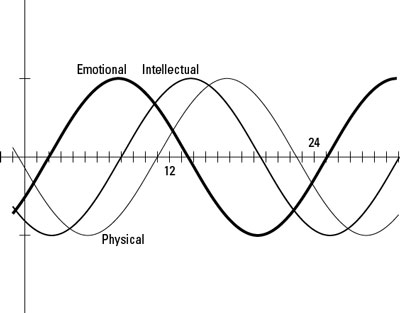
In 1904, Viennese psychology professor Hermann Swoboda came to similar conclusions. He labeled the 23-day rhythm "male" and the 28-day rhythm "female", matching the menstrual cycle. Fliess believed that he observed regularities at 23- and 28-day intervals in a number of phenomena, including births and deaths. The 23- and 28-day rhythms used by biorhythmists were first devised in the late 19th century by Wilhelm Fliess, a Berlin physician and friend of Sigmund Freud.

In addition to the three popular cycles, various other cycles have been proposed, based on linear combination of the three, or on longer or shorter rhythms. There is no particular meaning to a day on which your rhythms are all high or all low, except the obvious benefits or hindrances that these rare extremes are thought to have on your life. In general, a rhythm at 0% is crossing the midpoint and is thought to have no real impact on your life, whereas a rhythm at +100% (at the peak of that cycle) would give you an edge in that area, and a rhythm at -100% (at the bottom of that cycle) would make life more difficult in that area. The numbers from +100% (maximum) to -100% (minimum) indicate where on each cycle the rhythms are on a particular day. Each of these cycles varies between high and low extremes sinusoidally, with days where the cycle crosses the zero line described as "critical days" of greater risk or uncertainty.

Although the 28-day cycle is the same length as the average woman's menstrual cycle and was originally described as a "female" cycle (see below), the two are not necessarily in synchronization. Most biorhythm models use three cycles: a 23-day physical cycle, a 28-day emotional cycle, and a 33-day intellectual cycle. The theory is built on the idea that the biofeedback chemical and hormonal secretion functions within the body could show a sinusoidal behavior over time. These cycles begin at birth and oscillate in a steady (sine wave) fashion throughout life, and by modeling them mathematically, it is suggested that a person's level of ability in each of these domains can be predicted from day to day. Īccording to the theory of biorhythms, a person's life is influenced by rhythmic biological cycles that affect his or her ability in various domains, such as mental, physical, and emotional activity. The Biorhythm Chart when a person was born.


 0 kommentar(er)
0 kommentar(er)
